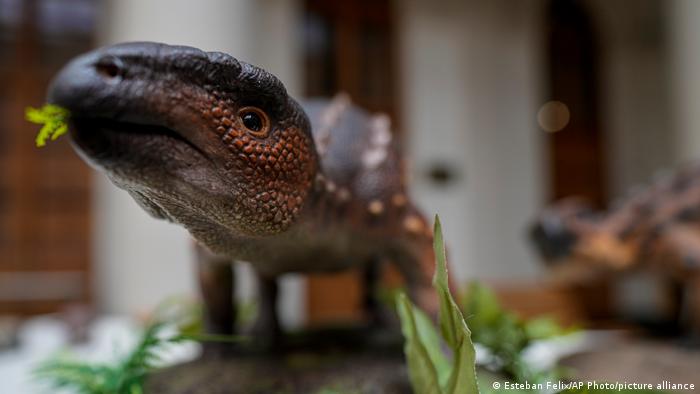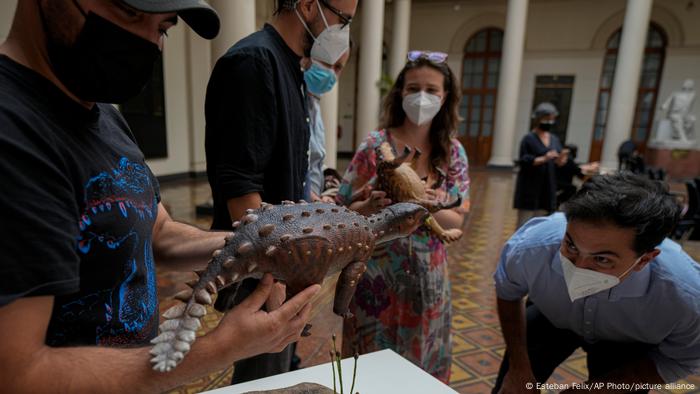AFP
December 1, 2021

Miniature models of the Stegouros elengassen, a species of dinosaur discovered in Patagonia in 2018, is seen on display December 1, 2021 in Santiago - Copyright AFP PATRICIA DE MELO MOREIRA
Chilean paleontologists on Wednesday presented their findings on a dinosaur discovered three years ago in Patagonia which they said had a highly unusual tail that has stumped researchers
The remains of the Stegouros elengassen were discovered during excavations in 2018 at Cerro Guido, a site known to harbor numerous fossils, by a team who believed they were dealing with an already known species of dinosaur until they examined its tail.
“That was the main surprise,” said Alexander Vargas, one of the paleontologists. “This structure is absolutely amazing.”
“The tail was covered with seven pairs of osteoderms … producing a weapon absolutely different from anything we know in any dinosaur,” added the researcher during a presentation of the discovery at the University of Chile.
The osteoderms — structures of bony plaques located in the dermal layers of the skin – were aligned on either side of the tail, making it resemble a large fern.
Paleontologists have discovered 80 percent of the dinosaur’s skeleton and estimate that the animal lived in the area 71 to 74.9 million years ago. It was about two meters (almost seven feet) long, weighed 150 kilograms (330 pounds) and was a herbivore.
According to the scientists, who published their research in the journal Nature, the animal could represent a hitherto unknown lineage of armored dinosaur never seen in the southern hemisphere but already identified in the northern part of the continent.
“We don’t know why (the tail) evolved. We do know that within armored dinosaur groups there seems to be a tendency to independently develop different osteoderm-based defense mechanisms,” said Sergio Soto, another member of the team.
The Cerro Guido area, in the Las Chinas valley 3,000 km (1,800 miles) south of Santiago, stretches for 15 kilometers. Various rock outcrops contain numerous fossils.
The finds there allowed the scientists to surmise that present-day America and Antarctica were close to each other millions of years ago.
“There is strong evidence that there is a biogeographic link with other parts of the planet, in this case Antarctica and Australia, because we have two armored dinosaurs there closely related” to the Stegouros, said Soto.
Newly discovered dinosaur had 'blades' on tail
From its bird-like snout to a tail that resembles an Aztec weapon, a new dinosaur species discovered in Chile is thrilling scientists. "It just looks crazy," said one researcher.

Scientists in Chile spent years puzzling over the dinosaur's 'bizzarre' tail
A new species of dinosaur that was discovered in Chile had a tail never seen in prehistoric fossil remains before, scientists announced on Wednesday.
Paleontologists said the exciting fossil find shows how much is left to uncover about the giant (and also not so giant) creatures who roamed the Earth millions of years ago.
What do we know about the new species?
The new species, dubbed "stegouros elengassen," has been puzzling researchers since its remains were found three years ago in Chile's Patagonia.
The dinosaur's fossils indicate it lived around 72 million to 75 million years ago, scientists said in a study published in the journal Nature.Scientists were able to recover around 80% of the animal's remains.
While other dinosaurs had spikes that could be used to stab enemies or hardened tail tips that could be used as a club — the stegouros could slash at its enemies.
Its tail contained seven pairs of "blades" that were fanned out — bearing a strong resemblance to a weapon used by ancient Aztec warriors.

Stegouros had a bladed tail that bears a striking resemblance to an ancient Aztec weapon
The dinosaur also had a bird-like snout and several hardened, armor-like bones that likely also served as a deterrent. The jutting armor would have made stegouros particularly "chewy" for predators.
Stegouros around two meters (around seven feet) long, but was only as tall as a dog. It is believed to have weighed 150 kilograms (330 pounds) and was a plant-eater.
While its name suggests a link to the stegosaurus — several rounds of DNA analysis revealed that stegouros is only distantly related to the pointy-plated dinosaur.
Instead, stegouros is considered to be "the lost family branch of the ankylosaur" — a type of dinosaur known for its tank-like appearance, thick armor and club tail.

Paleontologists recovered over 80% of the stegouros remains
Why is the discovery significant?
The unique structure of the tail sets the stegouros apart from every other currently-known dinosaur.
"It's a really unusual weapon,'' said Alex Vargas, a paleontologist at the University of Chile and lead author on the study.
"Books on prehistoric animals for kids need to update and put this weird tail in there," Vargas told the Associated Press. "It just looks crazy."
The location where the fossils were found were also surprising to researchers.
The stegouros bones were found in southern Chile in "a region that hasn't yielded these types of animals before,'' Kristi Curry Rogers, a Macalester College biologist who wasn't part of the study, told the Associated Press.
The discovery also shows that "we're just scratching the surface when it comes to a comprehensive understanding of dinosaur diversity,'' Rogers said.
"Stegourus reminds us that if we look in the right places at the right times, there is so much more still to discover,' she added.'
rs/rc (AP, AFP)
No comments:
Post a Comment